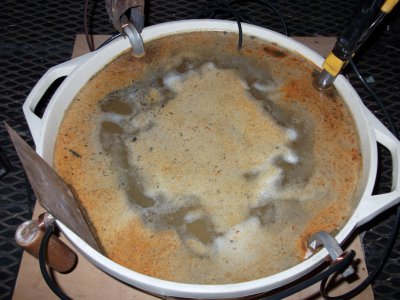- Joined
- Mar 10, 2012
- Messages
- 1,368

Lets begin with the absolute, electroplating rust off an object, and electrocleaning oil based dirt off an object are different processes.
I'll also point out electrocleaning a greasy machine can and often does leave behind the nongrease portion of the grime as a nasty crust similar in appearance to coral.
Electrocleaning is accomplished with a Sodium Silicate electrolyte NOT the Sodium Carbonate electrolyte normally used in rust removal.
Unlike derusting, the electrolyte in a cleaning tank cn and does contaminate, and will need to be replaced.
The receiving electrode must be equal in size or greater in size than the surface being cleaned.
Current should be limited to no more than 10 amps @ 24 volts DC
Accumulation on the receiving electrode will be less than in rust removal.
Filtration through a sand filter is highly recommended in cleaning
It will be best if the object being cleaned is removed from the tank every few hours and either scrubbed or pressure washed to prevent encrustation development.
As with rust removal process current is best adjusted by increasing or decreasing submerged surface area on the receiving electrode.
Using a car battery charger, I have had good results with both the 2 and 6 amp settings. . No need to use the maximum setting; you just need an adequate electrical potential. As discussed, it is important to routinely clean the anodes.
No disrespect whatsoever to those who have contributed thus far, but for the casual user there is no need to over think things. The process is quite simple, which is why it is so awesome.
BUT, there are a few catch-22's.....DON'T use stainless for an anode...it creates a toxic form of chromium and can easily be avoided. I hear that graphite makes a good anode which will not gunk up; never tried it. Not sure if it has been mentioned, but this process can actually plate certain things on your object. I learned the hard way by placing a headstock with bronze bearings in the dip. The cast iron somehow transfers to the bronze and "iron plated" it. (SPLAT, I hope you didn't suffer this fate) Not sure of the actual scientific process, but it is important to understand that dissimilar metals may get dissimilar results!
I'm in the process of refurbing my Heavy 10. I picked up a bottle of Citristrip yesterday and have been letting the headstock sit overnight with a couple of coats on it. I haven't started to clean it yet but it looks promising ....hopefully not too much work left to do after cleaning the Citristrip off it. Just had lunch and got to thinking about electrolysis. I found two helpful "how to's" here and here and was wondering if anyone had any other links or would care to post their own "how to"?
